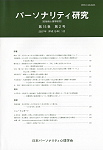Volume 20, Issue 1
Displaying 1-9 of 9 articles from this issue
- |<
- <
- 1
- >
- >|
Invited Article
-
Article type: Invited Article
2011 Volume 20 Issue 1 Pages 1-10
Published: July 30, 2011
Released on J-STAGE: October 25, 2011
Download PDF (449K)
Articles
-
Article type: Article
2011 Volume 20 Issue 1 Pages 11-20
Published: July 30, 2011
Released on J-STAGE: October 25, 2011
Download PDF (758K) -
Article type: Article
2011 Volume 20 Issue 1 Pages 21-31
Published: July 30, 2011
Released on J-STAGE: October 25, 2011
Download PDF (678K)
Exploratory Reports
-
Article type: Exploratory Report
2011 Volume 20 Issue 1 Pages 32-40
Published: July 30, 2011
Released on J-STAGE: October 25, 2011
Download PDF (619K)
Short Reports
-
Article type: Short Report
2011 Volume 20 Issue 1 Pages 41-44
Published: July 30, 2011
Released on J-STAGE: October 25, 2011
Download PDF (566K) -
Article type: Short Report
2011 Volume 20 Issue 1 Pages 45-49
Published: July 30, 2011
Released on J-STAGE: October 25, 2011
Download PDF (611K) -
Article type: Short Report
2011 Volume 20 Issue 1 Pages 50-52
Published: July 30, 2011
Released on J-STAGE: October 25, 2011
Download PDF (648K) -
Article type: Short Report
2011 Volume 20 Issue 1 Pages 53-56
Published: July 30, 2011
Released on J-STAGE: October 25, 2011
Download PDF (565K) -
Article type: Short Report
2011 Volume 20 Issue 1 Pages 57-60
Published: July 30, 2011
Released on J-STAGE: October 25, 2011
Download PDF (560K)
- |<
- <
- 1
- >
- >|
